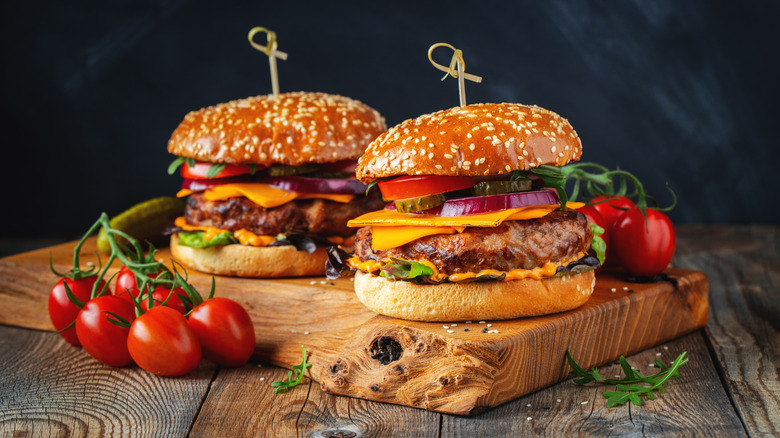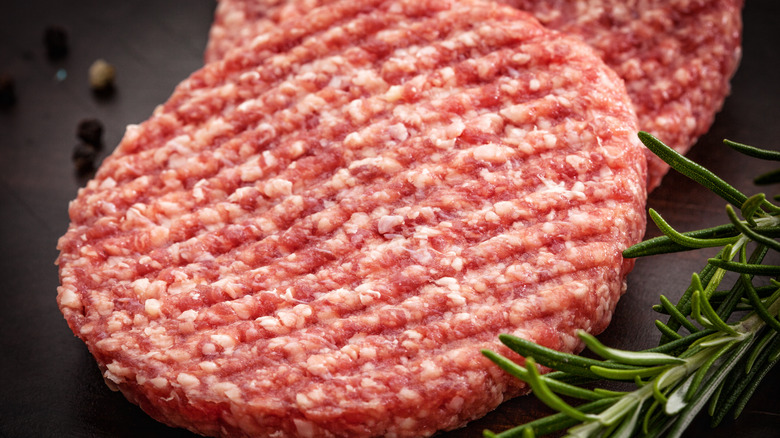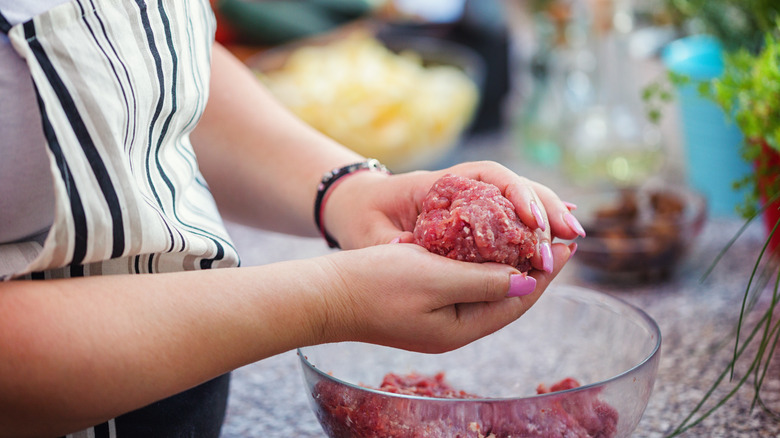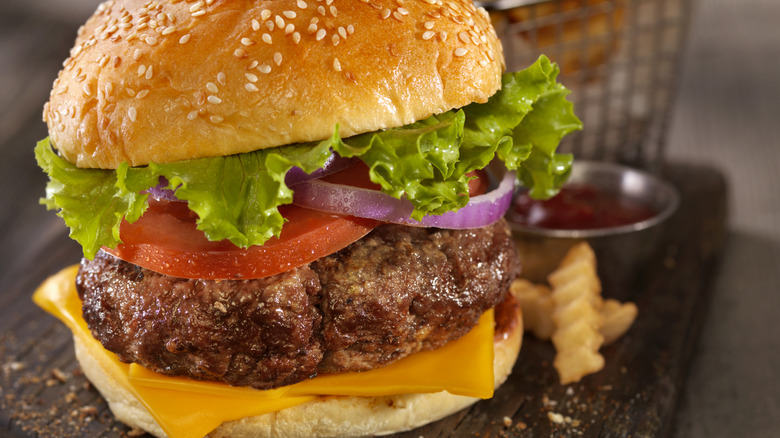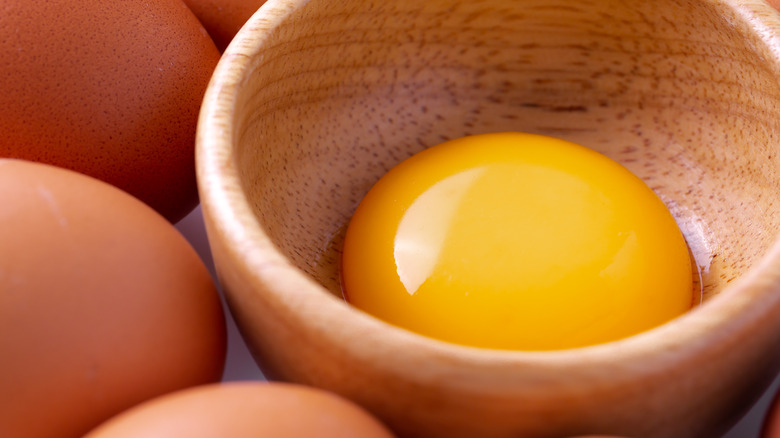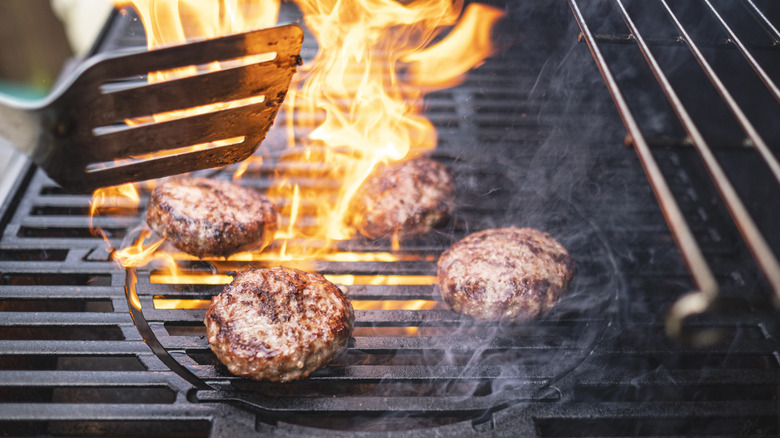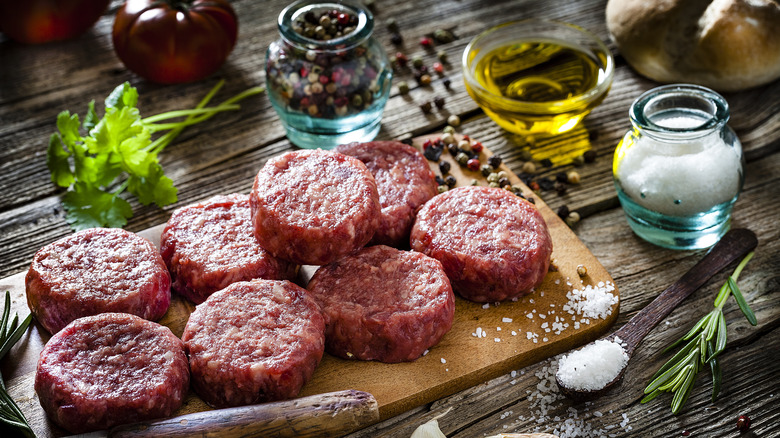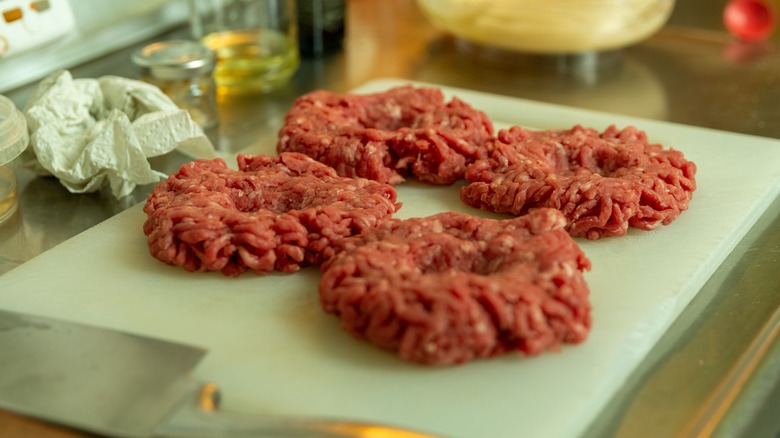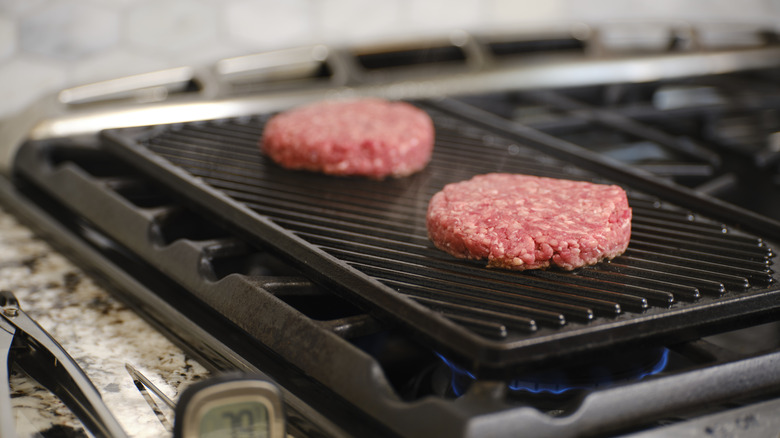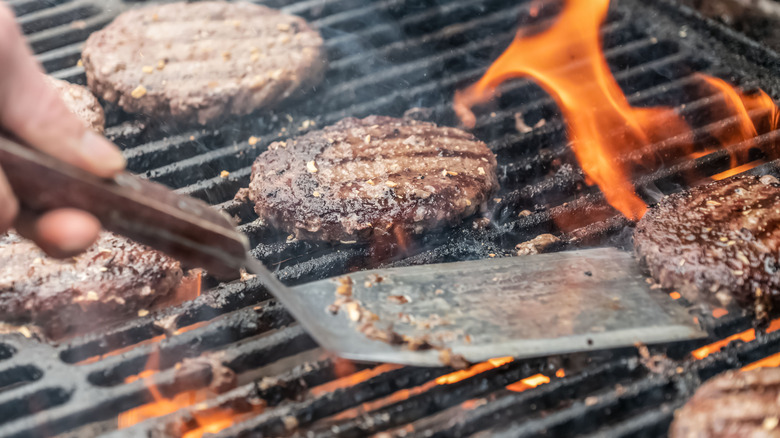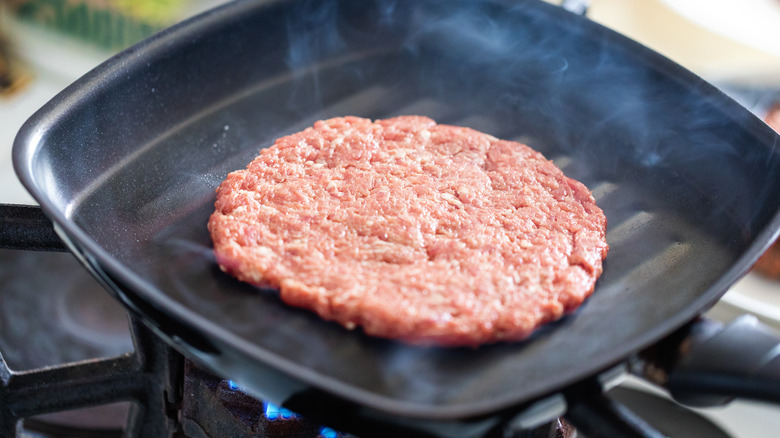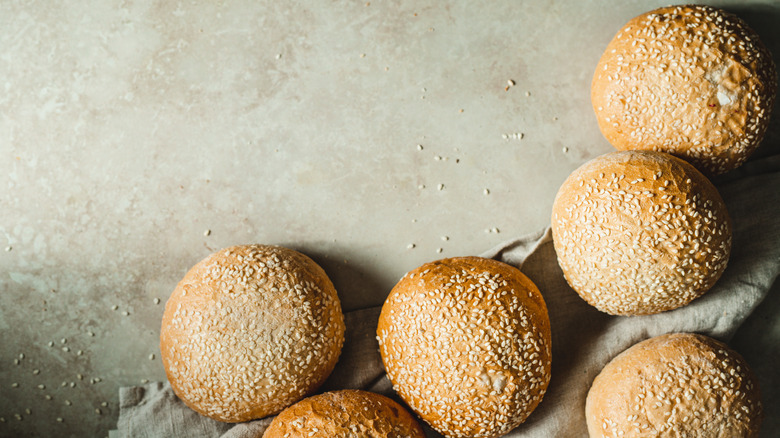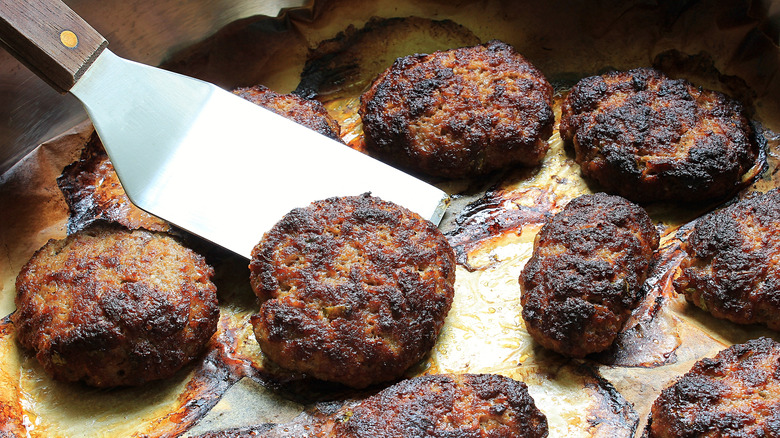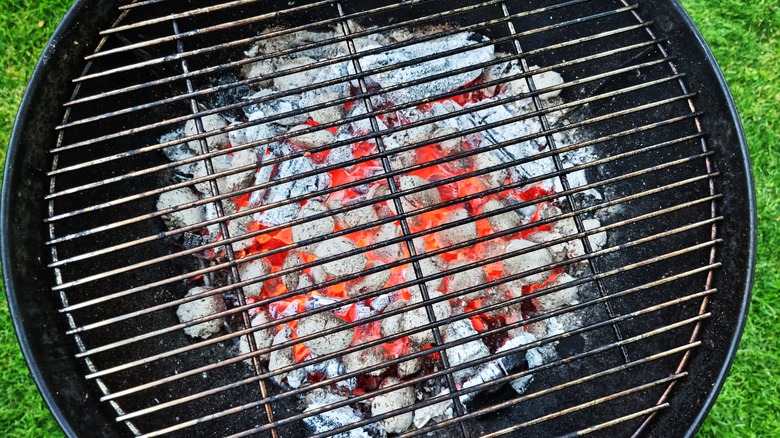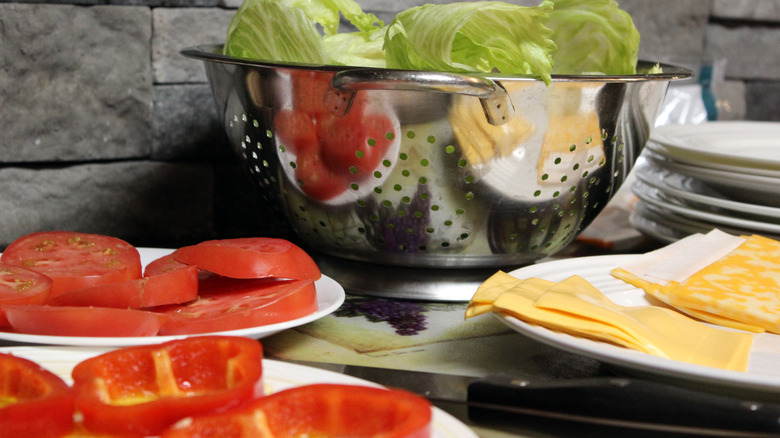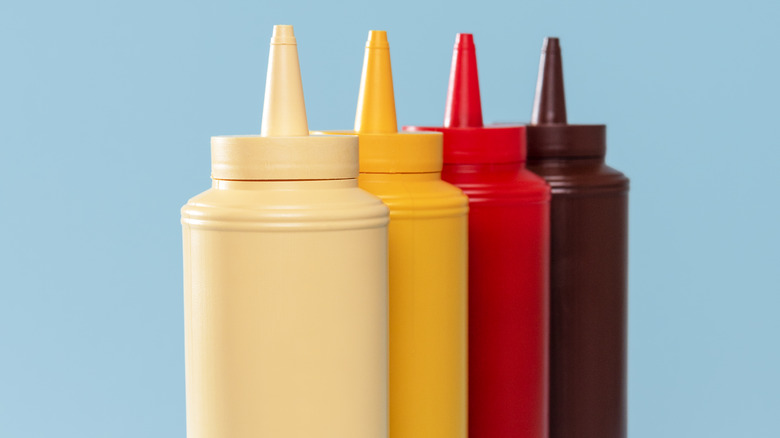15 Burger Mistakes And How To Avoid Them
To say burgers are popular is the understatement of the century. These timeless sandwiches are sold by countless restaurants and fast food chains across the country and around the world, and the king of them all, McDonald's, churns out 75 of them every single second to hungry customers. Both regular hamburgers and cheeseburgers were voted, alongside mashed potatoes, as the most popular American dish in 2022, with 84% of people saying that they were fans of the patty-and-meat combo, according to Statista. And with the plant-based food market producing ever-more-advanced burger alternatives that look just like the real thing, it's no longer a food that only meat eaters can enjoy.
But as anyone knows, a burger can go wrong fast. Making a burger is not as simple as just grabbing some bread and meat and putting them together. Every component has to be just right, from the right choice of hamburger bun to a perfectly formed and cooked patty to the correct order of toppings to ensure maximum taste and stability. And that's all before you get to which sauces you use. By pinpointing exactly which mistakes you're making with your burgers, you can make sure that your sandwiches are on point every time.
1. Using a poor fat-to-meat ratio
Hamburgers live and die by their fat-to-meat ratio, and while much is made of getting it right, it really does make a difference. In burgers, fat acts as a lubricant, moistening the meat and the patty and increasing its flavor. The leaner you go, the drier and more crumbly your burgers will be. Conversely, having too much fat can be a problem in itself, and things start to go really wrong when "you get up around 30[%] fat", says "Iron Chef" regular Michael Symon to the New York Times. High levels of fat can cause your burger to shrink excessively, says Symon, and may make your patties too oily.
Instead, the sweet spot is 80% meat to 20% fat. There's a touch of flexibility in this; some people may prefer a touch more fat or a higher meat ratio. Symon says that experimenting with your ideal proportions is the best way to figure out what's right for you. You can also experiment with different cuts of meat in your ground mixture, especially if you have easy access to a butcher, which may add a different flavor. A blend that has short rib or sirloin, for example, may taste richer or meatier. Remember, though, you really can't go wrong with ground chuck.
2. Overworking the meat
Making your own hamburger mixture at home can be rewarding and can also give you the peace of mind of knowing exactly what's in your food. But it can go wrong fast. There can be a temptation to make sure your meat is thoroughly mixed, and this can lead to overworking it. When this happens, you can mush the already-ground meat into pulp, breaking it down and compressing it too much. And then, when you come to cook your burgers, you'll find that they're mushy and have no texture to them.
Burger meat should only be mixed until it's just combined and the seasonings are incorporated, and no longer than that. Remember, you want your burgers to be well-formed but to have a good bite to them. You should also always work with fresh beef that hasn't been frozen beforehand. Freezing ground beef causes it to form ice crystals, which can tear the structure of the meat, thereby making it mushier. The crystals can also potentially cause your mixture to become too wet once they thaw. Fresh ground beef, on the other hand, will be firm and plump, with a good structure in the protein fibers.
3. Making them too big
A lot of folks crave a massive burger; for us, it's usually after watching an episode of "Man vs. Food." But while they may be exciting, the truth is that big burger patties just aren't that great. Many people make larger burger patties because they're worried about it shrinking when it's cooked, but doing so can make them difficult to cook. The heat takes longer to get through to the center of the burger, leaving the outside at risk of burning while you try and cook it all the way through. Furthermore, burger patties that are too big tend to become too dense and chewy. And to top it all off, they won't fit in your bun.
Instead, keep your burger patties on the smaller side. "Most of the time, 7 ounces is more than enough," says chef Michael Zakarian, as stated in the New York Times. Any bigger than that, and you're in trouble. "You want to get some heat to the inside of the burger. You don't want some giant, underdone meatloaf," Zakarian warns. You may find that our ideal burger is even smaller than that. It's a good idea to take the guesswork out of things and use scales to measure the weight of each patty or use a measuring cup or ice cream scoop.
4. Using a binder
Making burgers takes a certain amount of trust: That your seasoning will be right, that they'll be big enough, and above all, that they'll stay together when they're cooking. The latter leads folks to throw in binders, like eggs or breadcrumbs, to ensure that the meat doesn't fall apart.
But doing so will likely leave you with something that's closer to a meatloaf than a burger. Burger patties generally won't need a binder if they're pressed together properly, have a high enough fat content, and have time to solidify in the fridge. If you do add a binder, you can end up making the consistency too tight. Adding binders like egg yolks can also raise the fat content of a burger and may produce a patty that's too rich.
There is an exception to this rule, however. If you're adding extra ingredients into your patty, like chopped onions or chilies, you might find that a binder is useful to stop it from disintegrating once it hits the grill. We would recommend leaving those out of the patty itself, though, and using them as toppings instead, as putting extra items in burger meat can make it cook unevenly.
5. Making uneven patties
Homemade burgers have a rustic, rough-and-ready quality to them. But you can have too much of a good thing. If you're forming your patties with your hands, you can be left with a situation where your patties are oddly shaped, and this can create issues when they hit the heat. "You really want to make sure the patty is a uniform, even thickness, or it's not going to cook properly, which can lead to a burnt outside and undercooked inside," says chef Dino DeBell, per Eat This, Not That. Making burgers by hand can also produce differently-sized patties, which will cook at different speeds and leave some finished before others.
Avoid this by using utensils to make your burgers. "Flatten the patties by pressing them flat using a burger press," says Over The Fire Cooking's Derek Wolf. Burger pressed will give you a well-formed burger every time and will also ensure that you're not using too much meat. Wolf also suggests using pressing the meat between two flat surfaces, like cutting boards, if you don't have a burger press. This will give them the surface area needed to get a proper char on the meat. Just don't press too hard and flatten it entirely.
6. Overseasoning your burgers
Ground chuck is pretty flavorful, but if you've ever tried it without any seasoning, you'll know that it can be somewhat drab. But sometimes, people can try and counterbalance this by throwing every seasoning they have into burger meat. Unfortunately, this will end up completely overpowering the taste of the meat itself and leave your burger frankly pretty weird-tasting. Additionally, using seasonings like dried herbs can introduce new, brittle textures into a burger that may not soften as the patty cooks.
So, don't complicate things. "Over the years I've learned that buying high-quality meat and keeping the seasoning pretty basic creates a way better burger," says chef Vanessa Cantave to Mashed. "You get a great meaty flavor with a good char on the outside and juicy on the inside." All you really need to make your burger pop is good-quality salt and pepper and a few other choice seasonings if you want an extra kick. Cantave recommends using garlic and onion powder, but any more than that, and you'll start to distract from the beef itself.
7. Forgetting the dimple
If you've ever seen a pro make a burger patty, you might have seen them press an indentation into the middle of it at the end. But why do they do it? It's all because of how the meat reacts when it hits the heat. When the colder meat touches the hot grill, the parts that are closest to the heat shrink away. This creates more pressure on the inside of the burger, and that meat is then pushed up and out. As a result, even if your burger was flat when you formed it, the meat develops a rounded dome on top.
However, by putting a dimple in the middle of your burger, you essentially pre-empt this from happening. And then, when the meat starts to contract, it pushes the dimple out instead, leaving the top flat. You don't need your dimple to be too big for this trick to work; making one that's too big will risk it staying compressed. Simply take your index and middle finger and press lightly into the center of the burger, working in a round motion until there's a slight, even indentation. Make sure to cook the undimpled side first.
8. Cooking the patties from cold
Placing burger patties in the fridge after forming them can be useful for a few reasons. Not only does it help them firm up and solidify before you use them, but it also stops them from potentially developing any microbes while they wait to be cooked. But once you're ready to go, make sure you give them a bit of time at room temperature first. Cooking burgers straight from the fridge "Will make beef seize up, because of the sudden temperature change from cold to hot," explains "Food Network Star" finalist Jason Goldstein to Mashed. As a result, the meat will become too tough.
Keeping your burgers chilled for a while until you cook them will also mean they don't cook through properly. Remember, the average temperature of a fridge is 35-38 degrees, which isn't far off the freezing point. If you're trying to cook something that cold straight away, not only will you reduce the overall temperature of your skillet or grill, but the heat just won't move through it quickly enough — leaving you with a charred outside and a raw interior. Rather than create this misery for yourself, give your burgers 15 minutes or so out of the fridge before you cook them.
9. Pressing your patty down
It's hard to resist the temptation of pushing on a patty with a spatula. And aside from it being pretty fun, we can also see the logic. Pressing your patties ensures that more of it comes into contact with the skillet or grill and can give you a more even browning on the surface. It can also feel like a smart move if your burger is starting to bulge to keep it flat.
But we're here to tell you that, despite these things, you shouldn't be doing it. Pressing on a burger patty can force its juices out. This will not just make your burgers drier and less appealing but can also cause the juices to spit from the hot pan and onto your shirt or else down onto your coals or gas grill burner, resulting in a flare-up. Pressing on patties can also make them stick to the cooking surface you're using, and they're then tougher to flip.
So, while it may be fun, we really recommend leaving your burgers alone. The only situation we'd recommend pressing on your patties is if you're making smash burgers. If that's the case, the patty pressing should be done at the very start of the cooking process when it first hits the heat.
10. Using a grill
Grilling burgers is a time-honored tradition, but when you do so, you're accidentally drying out your patties. As burgers cook, they release grease and moisture, and on a grill, this drips straight away from the burger itself and into your machine. This can simultaneously raise the risk of a grease fire and also render your burgers less flavorful.
Instead, you should aim to retain as much grease as possible around your burger. "Grease is a condiment that is as natural as the beef itself," states George Motz, "Hamburger America" filmmaker and burger expert to the New York Times. "A great burger should be like a baked potato or sashimi. It should taste completely of itself." Using a grill to cook a burger can also be too temperamental: Grills are covered in hot spots and can reach supremely high temperatures, and this can leave your meat burnt.
There's no reason why you can't still use a grill in the cooking process, though — you just need something else on top of it. Motz recommends cooking burgers in a cast-iron skillet placed on top of the grill itself. That way, you trap all the grease around the burger but still get the satisfaction of cooking in the great outdoors.
11. Picking the wrong bun for your burger
A good burger is a collage of many different components, and the bun is more important than you might realize. Buns provide all-important structural support to a burger and provide the vessel by which you transfer it from the plate to your mouth. Importantly, though, certain buns don't go with certain burgers. Cheeseburgers, for example, don't fare particularly well with brioche buns, as aside from the bun potentially becoming too soft and adhering to the cheese too much, you may also get an overload of dairy flavors.
So, make sure that your bun is the right choice for the burger you're making. Brioche buns can be fiddly and overly sweet sometimes, but they tend to work pretty well with burgers that have lighter elements, like those with a sharp slaw or veggie burgers. Potato buns, on the other hand, are great for cheeseburgers, as they have a robustness that stops them from becoming mushed into the cheese. If you really want to let the flavors of your meat shine through, go for a milk bun. Milk buns have a relatively neutral flavor and have a versatility that allows them to be used with chicken and beef burgers alike. Whatever you do, though, don't go for a crusty bun — it'll get too flaky.
12. Overcooking the meat
If your burger patty isn't cooked well, you will inevitably have a disaster on your hands. And while an undercooked burger patty can present a risk of food poisoning, an overcooked patty is troublesome in its own way. Overcooked patties can be totally dry and chalky, turning what should be a moist food item into a rubbery one. Overcooked patties can also develop burnt flavors on their outside, which will inhibit all the other flavors in your sandwich.
The truth is that, unfortunately, there's no hard and fast rule about how long you should cook your burgers. Cooking times can vary considerably depending on how thick your burger is. Generally, though, most burgers will be done in about 8-10 minutes, with slightly less time needed if it's especially thin and more time if it's chunky. Aim for 3-4 minutes on the first side before flipping, avoiding the impulse to prod and move it. If you want to be absolutely certain that the interior is cooked to your liking, use a heat thermometer to check its doneness. A measurement of 160 degrees Fahrenheit will mean it's completely cooked through. It's also important to remember that a burger will carry on cooking slightly once it's off the grill, thanks to residual heat, so it might be useful to take it off a minute before you think it's done.
13. Forgetting to preheat your cooking surface
To make a burger the best it can be, you need heat — and a lot of it. But one thing you have to do is make sure that the heat's there before you put the patty on in the first place. "One of the biggest mistakes people make is putting the patty on the grill before it's reached the right temperature. Just because the fire is going, doesn't mean the grill is ready to use for cooking," says chef Jose Icardi, per Eat This, Not That. If your grill is still heating up while you put your hamburger on, it will cook too much on the outside and won't reach the proper temperature to cook it through quickly enough.
The same goes for cooking it in a skillet — unless it's hot enough to begin with, you're going to have problems. The solution is to be patient. Grills can take up to 15 minutes to heat to the proper temperature. And if you're cooking in a cast-iron skillet on a grill, you then need to allow time for that to come up to temperature, too.
14. Getting the order of your toppings wrong
The toppings are arguably the best part of a burger, but they're not as simple as they seem to get right. Too many toppings can overwhelm a burger and distract from the meat itself, and too few toppings can be, for want of a better word, kind of pointless. The order of your toppings is also important. Stacking them in the wrong way can leave things falling out mid-bite or throw off the burger's balance, making it needlessly top-heavy.
The key is to remember that certain toppings can actually go underneath the patty. "I use iceberg lettuce and place it facing up on the bottom bun. That way, the lettuce cup catches some of the natural drippings," says chef Cory Harwell to Eat This, Not That. Harwell also opts to put his vegetables below the patty instead of on top of it — this can stop them from slipping out when you bite into it. Cheese, meanwhile, usually goes on top of the meat so that it can melt and drape itself over the burger. As for your condiments, make sure you split them up between both buns so that you get the full effect of each one separately.
15. Using the wrong condiments
Condiments usually make a burger so much better. While in an ideal world, the juiciness of your burger would provide enough moisture, oftentimes, the lubrication that condiments deliver makes the sandwich way more palatable. But not all condiments will work on a burger, and when people start making things too complicated by using artisanal sauces or super-complicated dressings, they start to get in the way of the basics of the sandwich.
The best rule of thumb is to use no more than three condiments. Remember that condiments aren't just sauces, either: They can be solid, like pickles, onions, and chilies. Try to use contrasting flavors that aren't too far apart from each other so as to cause a clash, and always remember that your primary aim is to highlight the flavor of the burger, not distract from it. Crucially, too, even some of the most well-known condiments don't work that well in burgers. Ketchup, for example, isn't recommended by hamburger connoisseur George Motz, as it can create flavor clashes with the beef. BBQ sauce can also be too sweet, whereas soy-based sauces or condiments may be overly savory.
Static Media owns and operates Daily Meal and Mashed.
